If you’ve heard about how writing technical specifications results in successful software projects, you might now be wondering how to create those for the product you’re making.
This article is here to guide you through all the elements you have to include in your technical specifications to make them a valuable resource for your development team.
We’ll show you how to write this type of software document so that it contains all the necessary information your team needs to build an excellent product efficiently.
Start With the Front Part
Before diving into the nitty-gritty of the solution, you should first cover the very basics.
The front part of the technical specifications document references the project name, authors, time of creation, and information about the updates.
Here’s how these bits of information are organized in the header of the EU’s eSender technical specifications.

Source: TED eSentool
Considering how software teams are prone to changes, especially those teams adopting agile principles, listing the exact team members who worked on the technical specifications can be helpful even years down the road.
When somebody inevitably asks who added a particular parameter and why, well-constructed technical specifications can clarify the code ownership.
In the following image, you can see how the eSender technical specifications list the exact contributors in the document history.
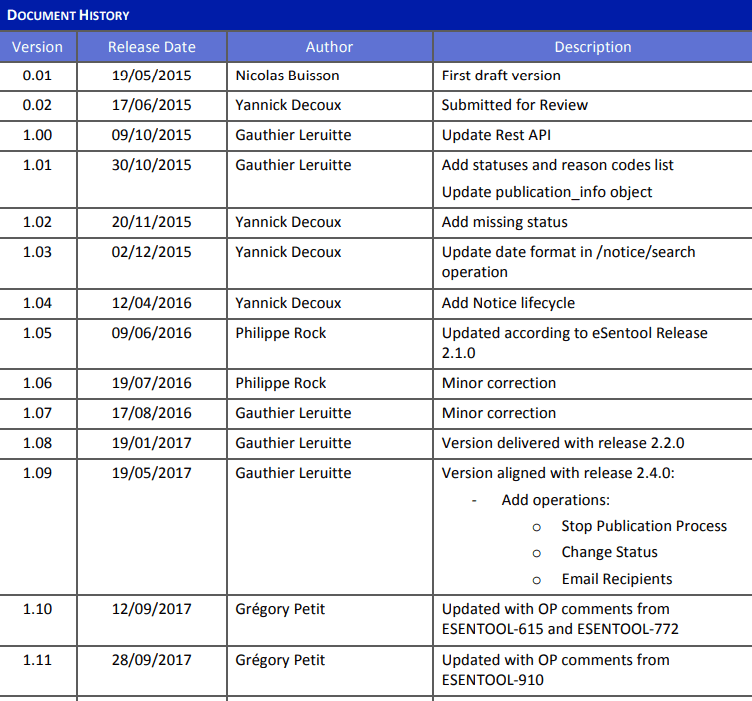
Source: TED eSentool
That way, readers can learn more about each iteration of the document, find who changed it, and determine when the change was released.
Once you’ve made these technical details known, it’s time to show the broader context of your product.
Provide an Overview
The overview of your product is the part of the technical specifications that introduces the readers to the problem your product solves.
To make your overview as informative as possible, you should provide the readers with a summary of the problem, clarify the terminology used in describing your product, and offer additional context.
Summary
Summary, abstract, description—whatever you call it, this part of the specifications concisely presents the main idea behind your product.
You shouldn’t make that introductory part longer than a few sentences—there’s room for more details later in the document.
Here’s a well-written summary of the OAuth 2.0 protocol’s technical specifications that you can use as a reference.
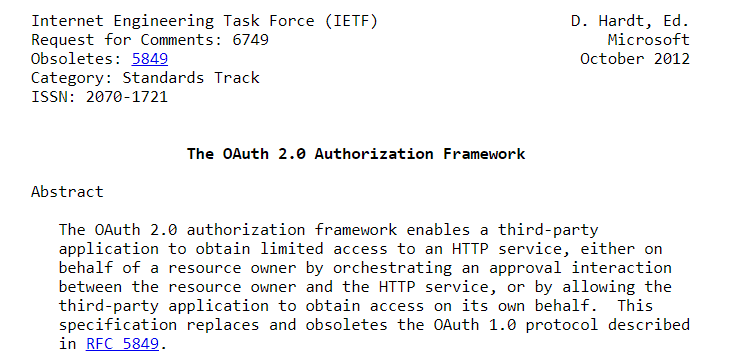
Source: IETF Datatracker
In addition to describing your product, you could also add a sentence or two about the problem your product solves.
Glossary
Considering that you’ll soon get technical and start describing the elements of your product and how they interact, you have to equip the readers with the tools needed to understand the tech spec.
The easiest way to do this is with a glossary.
Let’s go back to the eSender tool, whose header we’ve analyzed earlier.
If you started reading the specifications and came across the phrase “OP comments from ESENTOOL-921”, you probably wouldn’t know what kind of comments those are.
However, a look at the list of abbreviations and acronyms used in the specifications clarifies the meaning that the abbreviation “OP” has in the context of the product.
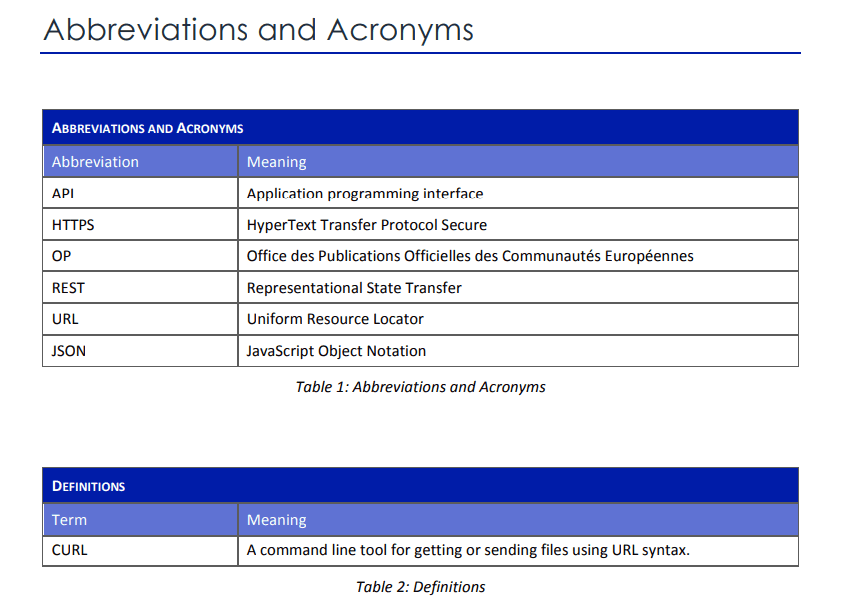
Source: TED eSentool
Depending on your target audience, the technical specifications written for your software probably won’t have to explain API, URI, and other standard acronyms used in the industry.
However, glossaries have an important place in software documentation, so it’s better to create one than to leave the readers guessing and potentially misinterpreting your technical specifications.
Background
Now that the reader is familiar with the general capacity of your product and is equipped with the terminology to understand it, you should convince them of the product’s value.
You can use the background section to describe the problem your product solves and mention why the problem is worth solving.
That’s precisely how the OAuth 2.0 technical specifications begin.
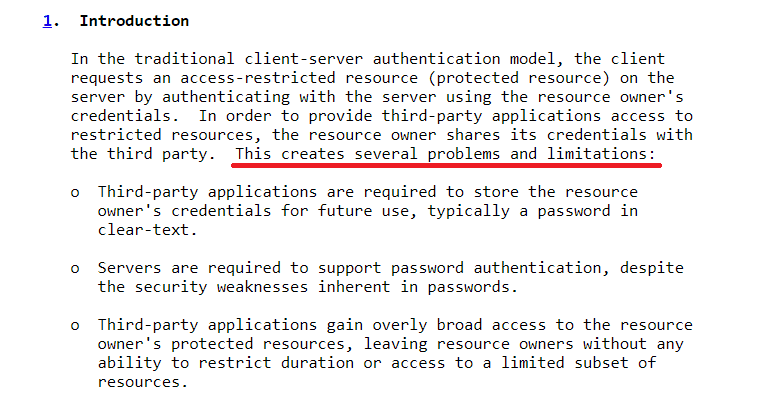
Source: IETF Datatracker
As you can see, the specifications identify several problems and limitations users frequently encounter with the traditional client-server authentication model.
Explaining how the problem affects end-users and businesses provides you with an opportunity to present your product as a beneficial, valuable solution, as seen in the following part of the OAuth specifications.
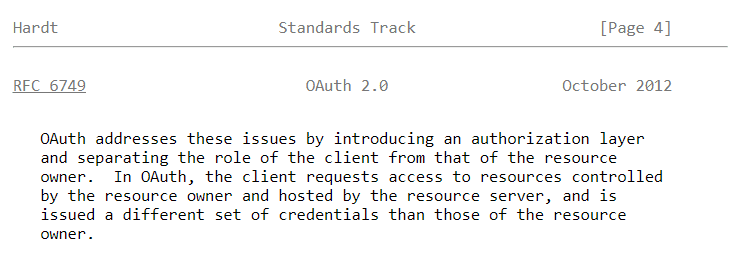
Source: IETF Datatracker
The background section is also a good place to outline the previous attempts that were made to solve the problem, explain why they didn’t work, and how your product overcomes the challenges.
Such an explanation is not only a neat overview of the product—you can also leverage it as a value proposition to boost your sales.
Lastly, the overview should also specify what’s out of your product’s scope.
Listing the non-goals lets all stakeholders know what the product isn’t designed to do, ensuring that everybody’s expectations are aligned.
After you’ve provided the context for your product, you can move on to the vital part of the technical specifications: explaining the solution.
Explain the Solution
A thorough analysis of the solution should be the main part of your technical specification.
This section displays the architecture of your product and the steps needed to implement the solution.
Since the content is so complex, writing this section will take the most planning and research, along with several rounds of review.
Let’s inspect the OAuth specifications once again.
The following image shows a part of their table of contents, and as you can see, the solution is dissected, and all its aspects are described in detail.
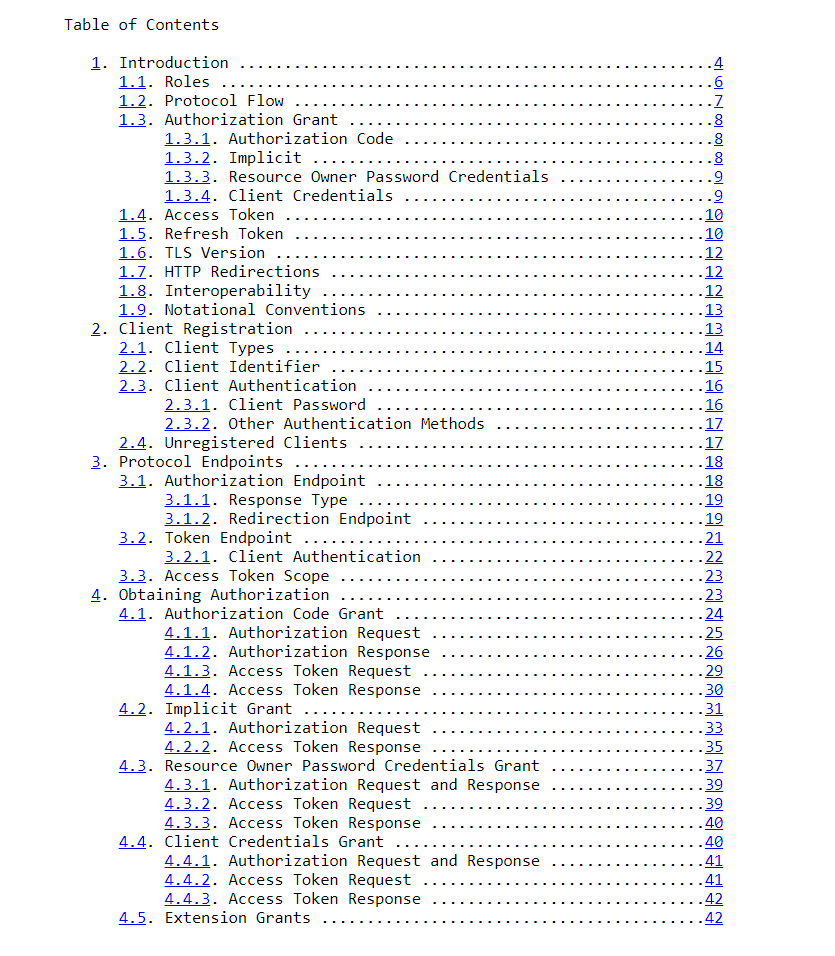
Source: IETF Datatracker
Each part of the protocol is explained in its dedicated section. Such a way of organizing content even allows easier referencing.
For instance, rather than describing cross-site request forgery each time, the document uses names of sections as standalone references, as seen in the following sentence.
“The parameter SHOULD be used for preventing cross-site request forgery as described in Section 10.12.”
Besides explaining the architecture of the solution, this section should also clarify how you will deploy it.
In other words, you have to construct a roll-out plan that specifies what roles take what steps to get the product up and running.
When you pair an in-depth description of the solution with an actionable roll-out plan, you’ll build an invaluable resource for all the developers and managers involved in the project.
Go Over Additional Considerations
You can only write a comprehensive technical specifications document if you cover all the aspects of the solution.
In most cases, this also includes how the solution affects businesses, users, and the privacy and security of their data.
While it could be argued that privacy and security are among the essential areas of the software to describe in the main part of the tech spec, it’s also common to address them as additional considerations.
For instance, OAuth dedicates sixteen individual sections of their document to various ways the solution deals with security issues, such as client impersonation, phishing attacks, clickjacking, and more.
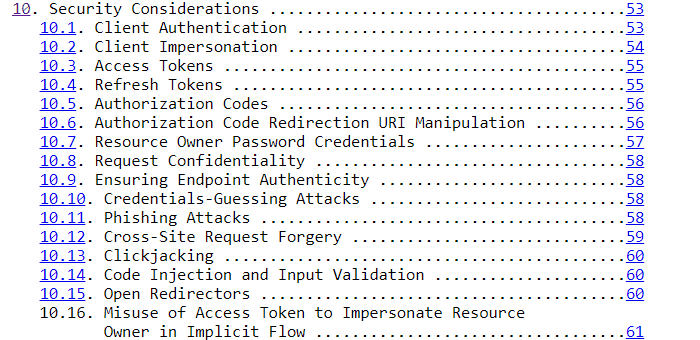
Source: IETF Datatracker
It’s especially important to describe how you handle security if your product is intended for external use—customers want to know how their data is protected.
Also, the section with additional considerations is a good place to describe how your software integrates with others.
Seeing that integrations aren’t only about your product, it makes sense not to include that information in the main section.
However, most modern apps do integrate with other pieces of software, so it’s best to elaborate on how your product is going to do that.
And now that you’ve outlined the entirety of your project, you should define how you will measure its success.
Explain How You Will Evaluate Success
In all probability, you’re not developing a product for fun—you’re doing it to achieve business goals.
Your technical specifications can tell you if you’re on the right track if you include the evaluation criteria in the document.
That’s right—technical specifications aren’t only limited to the product's architecture. Explaining how you will evaluate success in the document can help you during and after the launch.
For instance, engineering teams at Lyft collaborate with data scientists to define the metrics they later use to direct the production by asking questions such as:
“Given our finite engineering resources, which feature is more important to build?”
Authors then include the defined metrics in technical specifications so that they’re available company-wide.
This part of the technical specifications is also beneficial after the release because it helps you measure if you’ve achieved the set goals, such as reaching 50K App Store downloads within 16 months or staying under your marketing budget.
In addition to cost metrics, your tech specs should explain how you’ll track production and security.
Here’s an overview of helpful metrics tracked in software development teams, created by Steven A. Lowe, a former product technology manager at Google.
Production analytics
mean time between failures, mean time to recover, application crash rate
Security metrics
endpoint incidents, mean time to repair
Agile development metrics
lead time, cycle time, team velocity
If you want to streamline the way you evaluate success, your tech specs should also determine which tools you’ll use to capture and measure metrics.
Add a Timeline and List Milestones
To turn your technical specifications from a static document into an actionable management tool, you should write a section with the planned timeline and milestones.
A clear overview of the dates by which the team should complete a milestone helps project managers direct the team and shows the developers themselves what work they should focus on.
So, if there’s a set deadline for completing the QA analysis by August 15th, the entire team has a goal to work towards.
Once you set realistic deadlines, don’t forget to update the technical specifications. If a milestone is pushed back, the new deadline should be visible in the specifications.
This approach will prevent possible deadline misunderstandings and ensure that the project is shipped without delays.
Consider Adding a Discussion Section
You are now nearing the end of your technical specifications document. But before you list the acknowledgments, you should see if there are any open questions left.
If so, you should address them in a separate section.
Ideally, the technical specifications should be an all-encompassing document that answers all questions about the product.
In reality, it’s not that easy to wrap up the entire project by the time the specifications are released, which is why they often contain a section with unresolved questions.
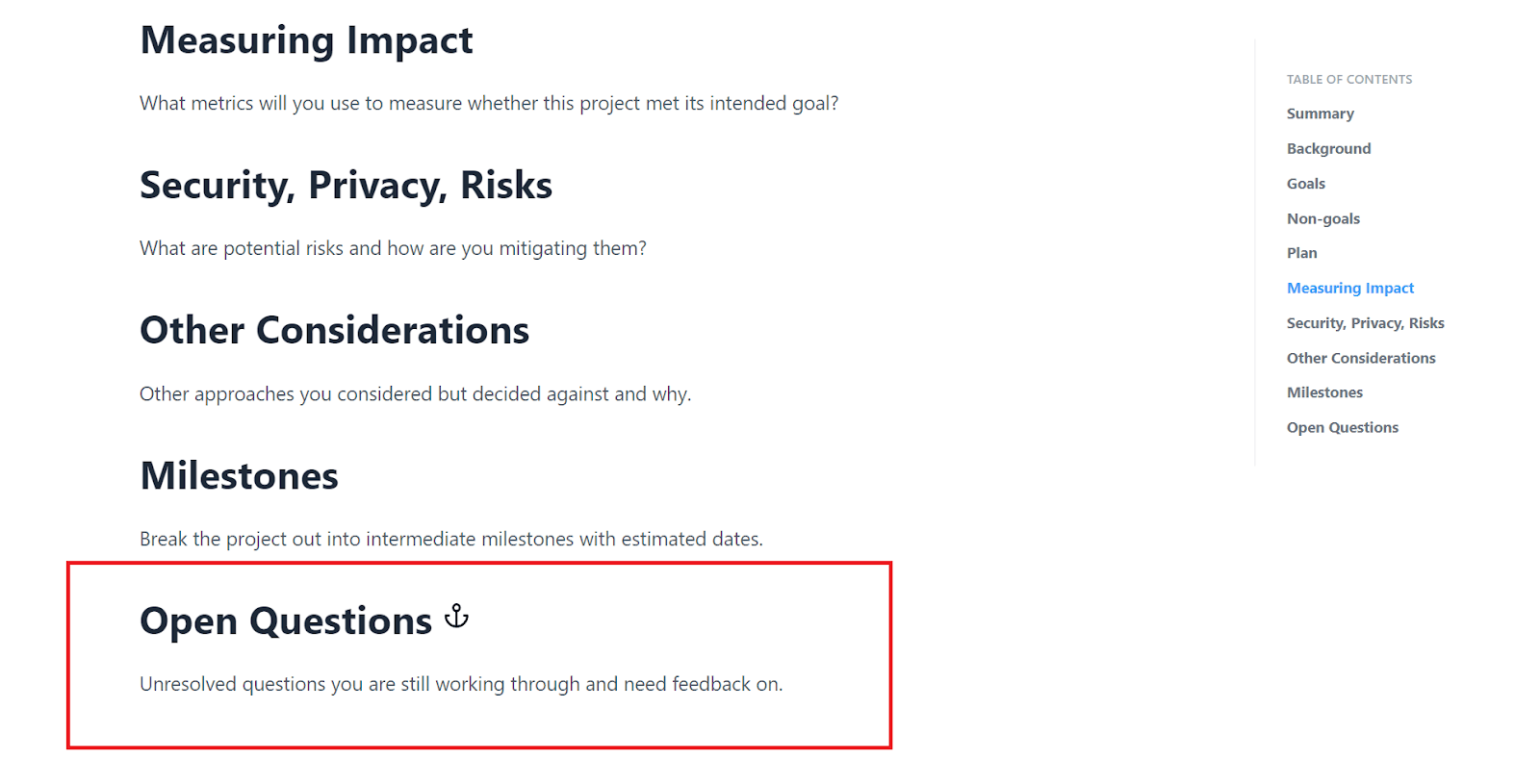
Source: app.archbee.com
In fact, the format is so popular that we’ve included it in our technical specifications template on Archbee, our documentation platform.
You can use the discussion section to list the potential elements of the product that are still a work in progress.
It’s worth noting that this section is predominantly found in technical specifications intended for internal use—if you’re broadcasting the docs to the world, it’s probably better to tie up all the loose ends before publishing.
Finish With the End Matter
Lastly, you can wrap up your technical specifications with a closing section that includes acknowledgments and relevant references.
This section doesn’t have to be a lengthy one. It’s enough to provide links to the resources and documents that can help readers better understand the concepts used in your product.
You can also use it as an opportunity to credit the authors who worked on the specifications by contributing ideas, feedback, code, and wording.

Source: IETF Datatracker
And that’s your tech spec document done!
Writing one may take some time, but once you get the hang of it, you’ll know how to write great technical specifications for each of your following projects.
Conclusion
If you want your team to get a clear view of what they’re about to build, you need to create comprehensive technical specifications.
By including the elements we’ve listed above, you’ll ensure that all the crucial areas of product design and development are covered. And, let's not forget about the fact that you also learn how to write technical specifications for the future.
So, before you dive into your next software project, feel free to use this guide to create a helpful document you can use as a roadmap.
FAQ
Frequently Asked Questions
Technical specifications align everyone on what will be built and how. They reduce ambiguity, document scope and non‑goals, and clarify architecture, interfaces, and acceptance criteria. Good specs make estimation and sequencing easier, surface risks and dependencies early (including security and compliance), provide a rollout plan and milestones, and capture ownership and revision history for traceability. The result is faster delivery, fewer reworks, and a shared source of truth for onboarding and ongoing maintenance.



